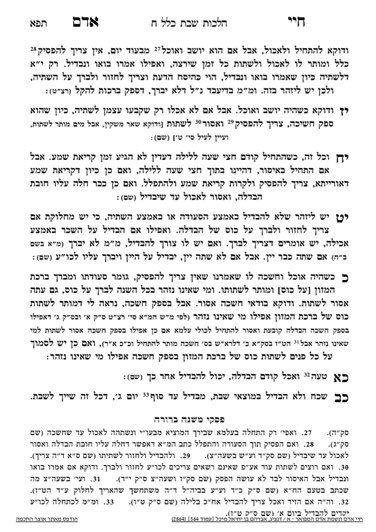We are beginning siman 12. The Chayei Adam writes that women are chayav in havdalah in the same way they are chayav in kiddush. According to the Rambam’s opinion, that we connect between zachor and shamor, we understand there is a strong argument that women are chayav in havdalah mideroaysa, just like they are chayav in kiddush (see more in yesterday’s shiur).
However, the Chayei Adam writes that there are some who hold that havdalah is not dependent on zachor and shamor, because the hekkesh (the halachic connection) between zachor and shamor only applies on Shabbos itself. We have learned that while zachor applies during the week as well (S2-S6), shamor only applies on Shabbos and not during the week. If we are not connecting zachor to shamor, the mitzvos asei are no longer connected to the issurim of Shabbos, so havdalah becomes just a mitzvas asei shehazman grama, in which women are patur. Another argument is that the mitzvos related to Shabbos in which women are chayav are only where there is an action involved in them. Women are not chayav in mitzvos which are only speech.
We have two differing opinions about whether women are chayav in havdalah. Many poskim, including the MIshnah Berurah, assume women are chayav in havdalah. The Chayei Adam’s approach is that it is a safeik, so they cannot make their own havdalah as it is a safeik bracha levatalah. Therefore, they should have a man be motzi them.
Taking this a step further, we know there is a concept of arvus, that Jews are responsible to help each other fulfill a mitzvah. Even if one person has fulfilled the mitzvah, they still have a chiyuv to make sure another person fulfills the mitzvah as well. Therefore, for example, a man who has already fulfilled his mitzvah of kiddush can be motzi another man in kiddush, because the first man has a chiyuv to help the other fulfill their chiyuv.
Applying this concept to havdalah, if a man already fulfilled his mitzvah of havdalah, and a woman asks him to recite havdalah a second time to be motzi her, if she certainly has a chiyuv, he could be motzi her due to this concept of arvus. If however, she does not have a chiyuv, or it is a safeik, a man would be unable to make havdalah a second time, as arvus is only to help people fulfill their chiyuvim. Therefore, the Chayei Adam concludes that it is assur for a man to make havdalah for a woman if the man has already made havdalah.
The Chayei Adam concludes that a woman can make havdalah for herself, because it is no different than other mitzvos asei shehazman grama (lulav, sefira, etc), where a woman can make the bracha even though she is not chayav in the mitzvah.
We will clarify the Mishnah Berurah’s opinion tomorrow, be’ezras Hashem.
Summary
- Although the Rambam holds women are chayav in havdalah like any other mitzvah deoraysa, the Chayei Adam’s opinion is that it is a safeik.
- Therefore, a man can be motzi a woman if he is being yotzei himself, but should not be motzi her if he was already yotzei.
- She can be motzi herself in the same way she can be motzi herself in any mitzvas asei that she is not chayav in.



